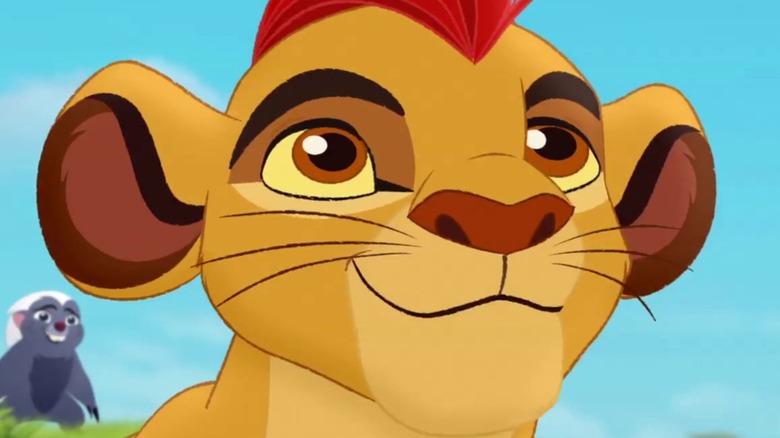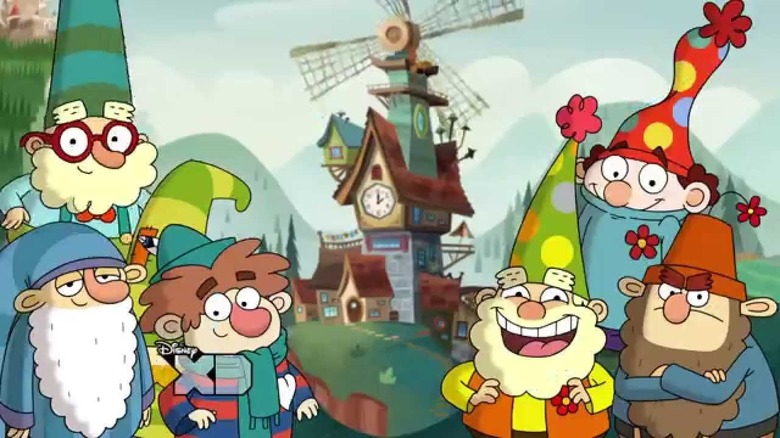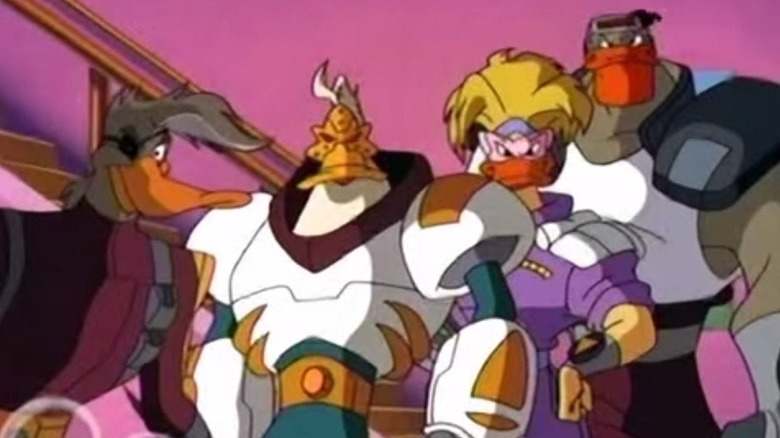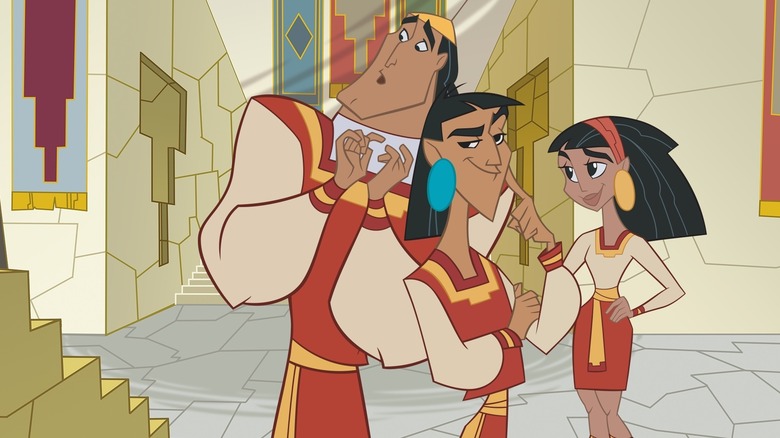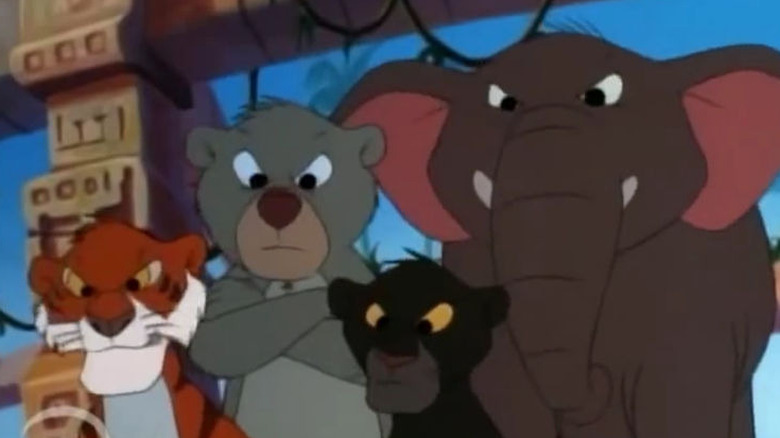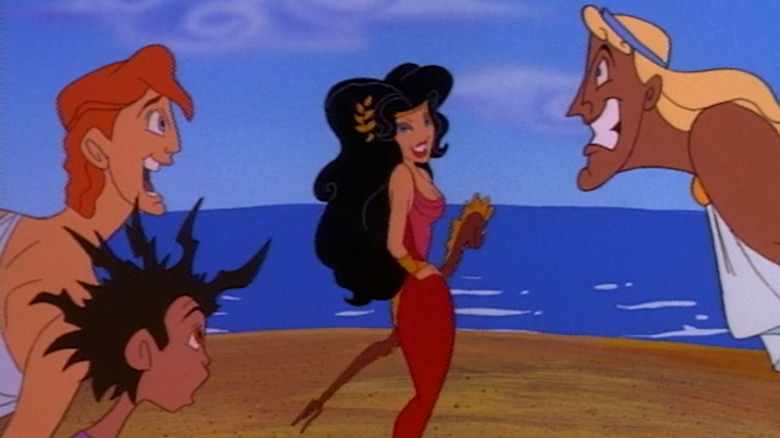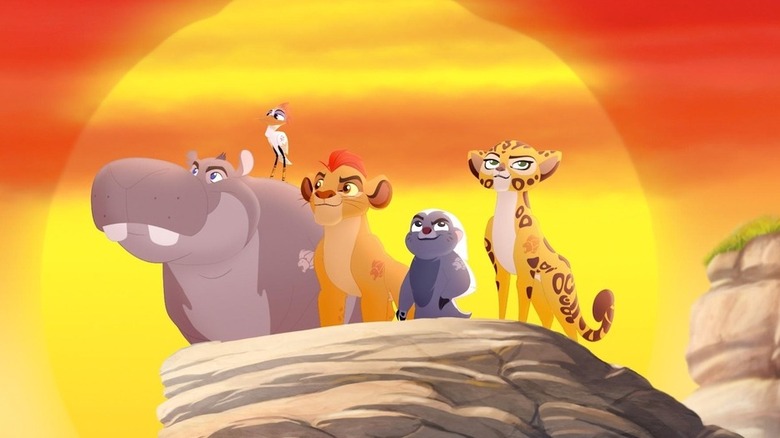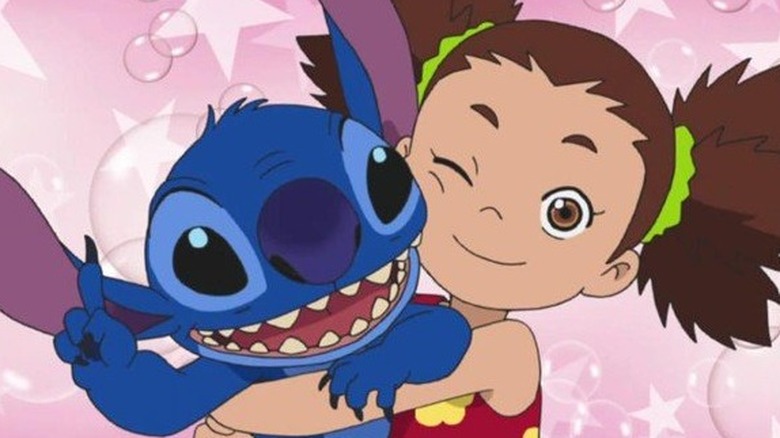Weirdest Disney Movie Spin-Off Cartoons You Forgot About
Disney animated spin-off shows are a tried and true tradition and are usually quite successful, from "Timon & Pumba" to "Buzz Lightyear of Star Command." Whenever the media giant finds itself with a hit movie on its hands, there's a safe bet you'll be seeing a cartoon series airing on the Disney Channel before too long. Over the years there have been many classic spin-offs that became just as beloved as the movies that originated them, spun out of great ideas: a popular sidekick that gets his own series, or extensions of the film that continued the story. Even some of the weird ones became classics, like "Muppet Babies."
But there were even more that failed or were taken off the air quickly and have been long forgotten. Some didn't last because interest in the movie they were based on faded, some were canceled because they just weren't very good. Some ended because they were just ideas too odd to be successful. But then there are the truly off-the-wall shows, the animated spin-offs that were just so bizarre that it's baffling why they made it to the screen at all. Here are the weirdest Disney TV spin-offs you likely forgot about.
The 7D (Snow White And The Seven Dwarves)
First up, and straight out of the "what were they even thinking" category, comes "The 7D", a fresh, bold new take on "Snow White and the Seven Dwarves" — or at least that's what it was supposed to be. It's unclear if "The 7D" title was meant to make the show sound hip and edgy, or to avoid reminding people of such an old property, but you'd think they'd want something with that fans would recognize. Whatever Disney's reason, right away viewers may wonder why anyone felt the need to reinvent the wheel by giving the show such an opaque title.
The animated children's spin-off launched in 2014 and was a new interpretation of the classic "Snow White" story, set in the whimsical world of Jollywood. Queen Delightful ruled over this kingdom, and it was up to the seven dwarves to protect it from Hildy Gloom and her husband Grim, a witch and warlock duo who attempted to overthrow the Queen by stealing jewels that were buried in the dwarves' mine. It didn't feel at all like the movie or the fairytale it was based on, and instead of a heartfelt children's adventure that would appeal to kids and their parents "7D" was a wacky slapstick comedy. Designed to appeal to younger children, the animation was extremely stylized, and while it definitely has a unique visual identity, it's unclear how this was supposed to appeal to fans of "Snow White." The show ran for two seasons before being canceled.
Mighty Ducks: The Animated Series
"The Mighty Ducks" was originally a live-action Disney feature film starring Emilio Estevez, a family sports movie about a ragtag children's hockey team that defies the odds and wins the state championship. The film spawned several sequels, with Emilio Estevez even returning in 2021 for a new movie that debuted on Disney+. The Walt Disney Company even founded an actual real-life NHL hockey team, the Mighty Ducks Of Anaheim in 1993 (known as "The Anaheim Ducks" since 2006). That the film begat an NHL hockey team though isn't even the oddest thing about the franchise.
Seeking an animated spin-off, you'd think Disney would make a cartoon based on the movie, about the kids and their adventures– in school and on the ice– or even a cartoon about the real NHL team, but no, those ideas would be too simple. Instead, Disney went the weird route: "Mighty Ducks: The Animated Series" is instead about a group of anthropomorphic hockey-playing alien duck warriors from outer space who land on Earth after a battle with their mortal enemies. The series came complete with a convoluted backstory and complex mythology involving a trans-dimensional war with a race of totalitarian lizard people, an evil fortress, an electromagnetic worm, a mask of leadership, and a battle for global domination. After all that, the alien duck warriors arrive on Earth in their spaceship, land in Anaheim, California and become... an official NHL hockey team. Not sure what was wrong with the 'kids in school' idea.
The Emperor's New School (The Emperor's New Groove)
The 2000 animated film "The Emperor's New Groove" was set in a Disney-fied version of the ancient Incan Empire, and saw the self-centered Emperor Kuzco learn a lesson about humility after he's turned into a llama, thanks to a botched poisoning with a magic potion. There was a direct-to-video sequel centered on the oafish Kronk, but a proper spin-off wouldn't follow for a few more years. That's when things got a little weird.
"The Emperor's New School" came to the Disney Channel in 2006, with some of the movie's voice actors returning for the series. The show is clearly set sometime after the film, even referencing events of the first movie, but the main character Kuzco inexplicably regresses to the selfish, narcissistic character he was at the opening of the film. Yzma is human again, despite being a cat the last time fans saw her. The weirdness isn't just in the inconsistencies; Instead of a simple Disney-fied Incan Empire, the series is set at an anachronistic academy, where Kuzco must once again learn a lesson — this time literally — to regain control of his kingdom. It's not a terrible idea in theory, but doesn't really make much sense as a spin-off of "The Emperor's New Groove." Did Disney only set it at a school so they could give it a similar-sounding title?
As weird as the show may be, fans were mixed on it. User reviews on sites like IMDB and Metacritic are split, with some claiming it is "the worst thing Disney has done" while others give it high marks while acknowledging it being "too weird to please everybody."
Jungle Cubs (The Jungle Book)
Disney has had a number of big box office hits over the years, and "The Jungle Book" was one of the studio's biggest when it released in theaters way back in 1967, and is generally regarded as one of the most important animated films of its era. It received widespread acclaim both for its story and its animation. It's no wonder that "The Jungle Book" got its own TV show, but it's a bit odd that it didn't hit screens in the 1960s, 70s, or even in the 80s, but in 1998, more than thirty years after the film debut.
Not a sequel to "The Jungle Book" (that would come in the form of a direct-to-video movie in 2003), but a prequel, "Jungle Cubs" followed the wild adventures of Baloo, Hahti, Bagheera, Louie, Kaa, and Shere Khan when they were children. In the series, some of the characters that ended up bitter enemies in the original film live together in peace. The show has the animals acting a bit more human than in the film, too. What's really weird, though, is why a follow-up took so long, and why in the late 1990s Disney looked all the way back to "The Jungle Book" as the source for a new animated spin-off series. Disney has dredged up classics this before, and it didn't end any better, with the bizarre live-action show "Dumbo's Circus" in 1985– that mixed actors and oversized puppets– more almost 45 years after the original "Dumbo" hit theaters. That too was canceled after just one season.
Hercules
One of Disney's most successful traditions is giving timeless tales their own spin and turning them into big hits. Such was not the case with the "Hercules" movie, Disney's big animated feature in the summer of 1997. Unfortunately their attempt to make a blockbuster out of the Greek mythological hero movie wasn't a success, because despite good reviews, it was considered a box office disappointment.
Because it wasn't a big hit, it was uncertain whether the property would become an animated series. Still, Disney must have felt that the adventures of the Greek god would make for a fun cartoon, Hercules being an ancient superhero of sorts after all. However, the animated series, "Hercules", which debuted in 1999 on The Disney Channel, was not what you might have expected. It wasn't about the super-heroic exploits of the classic mythological figure, using his tremendous strength, courage, and ingenuity to battle ancient monsters and protect the innocent, as he did in any number of ancient Greek myths.
No, his animated series instead centered on his teenage years where he attended school to learn to become a hero. In the cartoon, the young inexperienced Hercules had to handle his snobby schoolmates, deal with peer pressure, and other challenges a hero faces in high school... and fight some monsters and demons. Such were the labors of Hercules, defeating mythical monsters and struggling to pass his math test. Infamously, the show contradicted many elements from both the original Disney film as well as the Greek mythology that inspired it.
The Lion Guard (The Lion King)
"The Lion King," was one of Disney's biggest 90s hits, so an animated spin-off was a certainty. It came in the form of "Timon and Pumba" shortly after the release of the film, and ran for 85 animated episodes. "Timon and Pumba" is generally considered to be one of the best Disney spin-offs. So what is "The Lion Guard?" Put simply, it's a sequel to the Lion King, but also a prequel of sorts to "The Lion King II: Simba's Pride," but also a sequel to that film in some ways too. Confusing, right? It's confused fans, too, and has been the source of much debate among Disney diehards, as the lead character's mere presence doesn't even seem to make sense.
From what we can piece together, the bulk of the three-season series takes place in the middle of "The Lion King II: Simba's Pride" during an unseen gap of time, and follows a young Kion (Simba's son) who puts together 'The Lion Guard,' a special team assembled to defend the pride and protect the circle of life. Later episodes of "The Lion Guard" seem to take place at the same time as the second half of the movie sequel, and some episodes possibly take place after it. Fans have also pointed out a number of issues with the timeline, and consistency with the theatrical and direct-to-video sequels.
Whatever the truth about this confusing timeline may be, you have to ask yourself why they didn't just make a sequel to the second film.
Stitch! / Stitch And Ai (Lilo And Stitch)
"Lilo And Stitch" got its own animated series in 2003, just a year after the film released in theaters, and on the heels of the direct-to-video sequel, "Stitch: The Sequel." It proved to be very popular, running for 65 episodes across four years. But in 2008, the company made an odd move when Walt Disney Television International Japan, their foreign subsidiary, procured the rights from their parent company to produce an anime series, titled simply "Stitch!" The series was set in Okinawa, Japan and centered on Stitch and his new human friend Yuna. The series was well-received, and aired 29 episodes between 2008 and 2015, though only five have ever made it to America.
In 2017, a new series titled "Stitch and Ai" aired in China, and acted as a sequel to the original film, but set in Huangshan, Anhui. The series sees Stitch separated from Lilo after being captured by a group of aliens, and when Stitch escapes, he crash lands in the Huangshan Mountains where a young girl named Wang Ai Ling finds him and takes him in. The series was produced with English voiceovers, and then re-dubbed in Mandarin, with the English version releasing first. The only time it was made available in the US was as a streaming option on 'DisneyNow' in 2018, before being removed a year later.
The reaction to the show was positive, though with reviews praising the animation and storytelling, and unlike "The Lion Guard," fans were happy to be forgiving of the continuity errors it may have created with the original movie.
